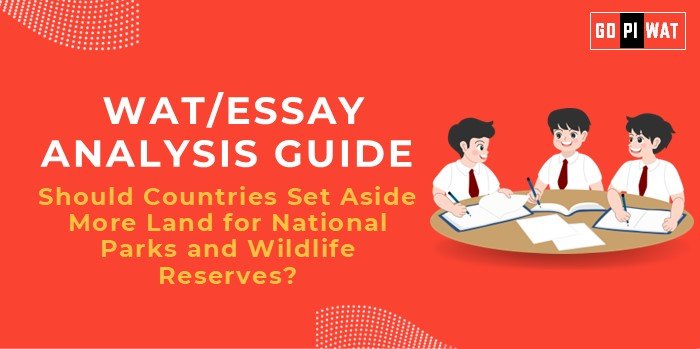📋 WAT/Essay Analysis Guide: Should Countries Set Aside More Land for National Parks and Wildlife Reserves?
🌍 Understanding the Topic’s Importance
The debate reflects tensions between economic development and environmental preservation. For B-school students, this essay connects with sustainable management practices and global SDG goals.
📝 Effective Planning and Writing
- Time Allocation (30 minutes): Planning (5 mins), Writing (20 mins), Reviewing (5 mins).
- Structure (400 words):
- Introduction (60 words): Contextualize the topic.
- Body (300 words): Explore achievements, challenges, and recommendations.
- Conclusion (40 words): Summarize key points.
💡 Introduction Techniques for Essays
- Contrast Approach: “While protected areas shield biodiversity, their expansion often conflicts with economic goals.”
- Solution-Based Approach: “Setting aside land for reserves offers a sustainable path to balance ecological needs and human ambitions.”
📚 Structuring the Essay Body
- Achievements: Increased biodiversity, tourism benefits, and climate resilience.
- Challenges: Funding gaps, human-wildlife conflicts, and development pressures.
- Future Outlook: Partnerships, innovative funding, and community involvement.
✅ Concluding Effectively
- Balanced Perspective: “Conservation efforts must integrate sustainable development to ensure mutual benefits for ecosystems and humans.”
- Global Comparison: “Countries like Costa Rica exemplify how reserves can drive both biodiversity and economic gains.”
✍️ Sample Short Essays
1. Balanced Perspective:
“National parks ensure ecological stability, yet their expansion must account for economic constraints. Countries can adopt models like Costa Rica, where reserves support biodiversity and tourism alike.”
2. Solution-Oriented:
“Expanding reserves is vital for biodiversity and climate goals. Public-private partnerships can fund these areas, ensuring development does not come at the cost of nature.”
3. Global Comparison:
“With Costa Rica’s success and Brazil’s challenges, it’s evident that prioritizing protected areas hinges on strong governance and community engagement.”


